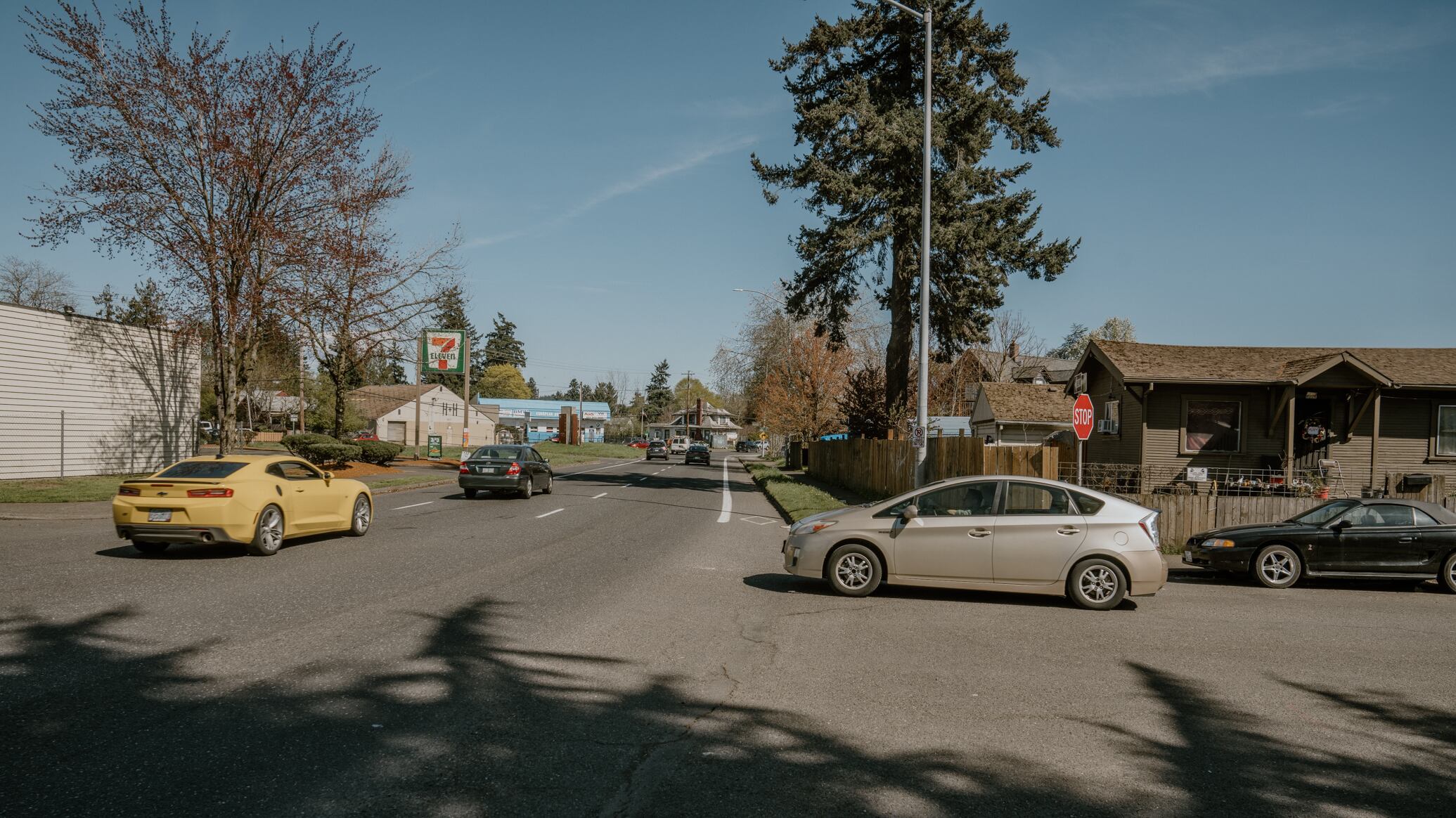The fate of Tom Amato had become a bit of a mystery to his childhood friend Jeff Warnock, who hadn’t seen him in over 30 years.
The two boys had grown up together in Ladd’s Addition in the 1960s. Warnock, Amato and Amato’s younger brother, Phil, were a trio of long-haired “motorheads” who listened to Black Sabbath and drank beers in the basement of the Amato home.
The three boys careened just about everywhere on motorcycles. “It was a sense of freedom for us,” Warnock recalls.
Amato had a big personality—gregarious to those who knew him well, gruff to those who didn’t. Warnock always wondered what happened to him.
In fact, he died on the blacktop. Amato was 71 years old this past Feb. 4, when he was struck and killed by a driver near the intersection of Southeast Woodstock Boulevard and 97th Avenue in the Lents neighborhood of Southeast Portland.
Tom Amato’s death was one of 17 so far this year in Portland traffic, after 75 last year. It also points to a larger mystery: how a city initiative to improve safety on the streets quietly vanished.
For years, city officials promised they would install a suite of safety improvements—including a crosswalk, a stoplight, a wider sidewalk, and a traffic median—at that very intersection. It was one of the first investments in a $600 million plan Portland Mayor Ted Wheeler launched with fanfare in 2018 to chip away at road and traffic safety hazards.
Six years later, when a driver killed Amato as he was walking along Woodstock, not one of the promised improvements on that block had been made. What’s more, when WW looked into Wheeler’s larger plan for infrastructure upgrades, we found it had been quietly abandoned, and what little work was funded six years ago remains incomplete.
That program, BuildPDX, was lauded by The Oregonian in March 2018, for “preempting the City Council from making decisions that could be swung by politics of the time.” Then-City Commissioner Steve Novick told the newspaper that Wheeler’s plan was “ingenious” and made an “unbreakable commitment” to infrastructure.
Since then, three of the projects funded in part by BuildPDX have been completed, including disabled-accessible ramps across the city and repavement of a stretch of North Lombard Street. But the completed improvements are a fraction of what Wheeler envisioned seven years ago. Of the $600 million pledge, just $25 million in bonds has been issued. By all accounts, the program is dead.
It’s difficult to measure the impact of a program’s failure to launch. Yet it’s clear Portland’s roads have deteriorated as BuildPDX stalled.
Over the past six years, the Portland Bureau of Transportation estimates, the cost of performing deferred maintenance has ballooned from $2.6 billion to $4.6 billion. And as transportation assets grow older, it becomes increasingly more expensive to fix them.
“It’s disturbing to hear that one of the brighter ideas to address our infrastructure problem has died on the vine,” says Novick, who’s now running for City Council.
Wheeler’s office declined to make him, or his chief of staff, available to speak with WW about BuildPDX and why it withered. In a written response, mayoral spokesman Cody Bowman says the city’s priorities shifted in the intervening years.
“Since the BuildPortland plan was introduced, the city was impacted by numerous crises—including rising homelessness, public safety and livability issues, and the COVID-19 pandemic—requiring leadership to refocus and reprioritize financial resources,” Bowman says.
Wheeler leaves office in eight months. Nonetheless, Bowman writes, “Mayor Wheeler supports having a larger discussion on infrastructure and transportation needs with his council colleagues moving forward.”
In March 2018, a fresh-faced Ted Wheeler, two years into his first term as mayor, led the Portland City Council to approve $50 million in bond funding for seven infrastructure projects across the city. They were the first projects to be funded as part of Wheeler’s ambitious “BuildPDX” plan, which aimed to invest more than $600 million in Portland’s streets and other infrastructure over a 20-year period.
Just two years earlier, amid high traffic deaths, the Transportation Bureau had launched “Vision Zero,” an initiative aimed at reducing traffic deaths to zero by 2025. BuildPDX would augment a gas tax passed by voters in 2016 to fund road repairs.
BuildPDX would launch seven initial projects and then build additional phases in subsequent years. (Six of the first seven projects were road improvements and street safety upgrades; one was to rehabilitate an East Portland community center. In some cases, BuildPDX money was the last bit of funding the project needed to move forward.)
Wheeler anticipated a windfall for the city’s general fund as urban renewal areas expired and freed up property tax dollars. He wanted to issue bonds incrementally to fund BuildPDX, then repay those bonds with the anticipated tax dollars over a 20-year period. He intended to issue $600 million in bonds over the lifespan of the program.
“Colleagues, BuildPortland is the means by which the city plans to address its infrastructure gap, which represents a significant long-term liability,” Wheeler declared from the dais. “We need a bigger, multiyear vision…to make critical investments in our core infrastructure.”
Three years later, at another council meeting, Wheeler remained positive.
“City Council has never had the discipline that we’ve had now with BuildPDX,” Wheeler explained to his colleagues, “the ability to fund $600 million in infrastructure that we didn’t have previously.”
If not for his program, Wheeler said, “these dollars would go into the general fund, and my fear is that we wouldn’t spend it on infrastructure, because infrastructure is boring. Nobody cares about infrastructure, and that’s why it never gets funded.”
But at that same June 2021 council meeting, BuildPortland project manager Geraldene Moyle raised a red flag. She warned that city bureaucrats had been caught off guard by BuildPDX and had to root around for projects to submit for the first round of funding.
“Bureaus were scrambling to put in projects that were ready and had pre-design funding,” Moyle said.
Moyle told the City Council that planning for the second phase of BuildPDX would ideally start in 2021, even though the actual Phase 2 funding—$100 million in bonds—wouldn’t be issued until 2024.
But that never happened.
Wheeler’s office and PBOT declined to make anyone available to WW to explain why the project failed to move to a second phase. But a March 2022 meeting of the City Council provides some clues. In that meeting, top staff warned the City Council that if it didn’t reserve some of the returning urban renewal funds to Prosper Portland, the city’s economic development arm, and the Portland Housing Bureau, those agencies would soon have to lay off staff and cut programs.
Later that year, the City Council responded to that concern. Starting this next fiscal year, Prosper Portland is slated to receive just under $8 million in returning urban renewal area funds per year, as will the Portland Housing Bureau. Another $4 million will go toward a harbor cleanup project.
That decision promised roughly two-thirds of the available annual dollars for BuildPDX to other city goals: housing and economic growth. Priorities had shifted, the very type of diversion Wheeler promised his initiative would avert.
BuildPDX fell by the wayside. There were no mentions in the news.
Commissioner Mingus Mapps is the current transportation commissioner. He says the failure of BuildPDX is just one example of how the City Council has left infrastructure to crumble.
“If you want to make progress on infrastructure, you have to work consistently and incrementally on your assets,” Mapps says. “You can’t ignore your roads and sidewalks for 15 years and then all of a sudden try and catch up.”
As for the first seven BuildPDX projects to get funding (which were also the last), two remain incomplete and two haven’t started. PBOT officials blame staffing shortages, rising construction costs due to inflation, pandemic retirements, and budget uncertainty.
Mapps says he takes responsibility: “That’s my shop, so I’m ultimately responsible for what gets built and not built.”
Former City Commissioners Jo Ann Hardesty and Chloe Eudaly, both of whom oversaw transportation for a time, did not respond to requests for comment.
Zachary Lauritzen, interim executive director of Oregon Walks, says road infrastructure crumbles because there’s never been a steady funding stream to maintain it.
“To Mayor Wheeler’s credit, he was trying to do something,” Lauritzen says. “We know this is not something that can be fixed tomorrow, but we sure as hell should have a plan in place and a funding mechanism in place so it’s not the exact same problem for the next generation.”
The two incomplete projects are renovations at the Mt. Scott Community Center in Southeast Portland and improvements along a stretch of Southeast Stark Street.
One of the unstarted projects is a replacement bridge on Northeast 42nd Avenue over Lombard, for which city officials say construction bids last year came in too high. The other is the safety improvements at the intersection near where Tom Amato was killed in February.
Friends who knew Amato choose to remember happier times.
A friend named Don, who worked at a steel manufacturing shop on Northwest Thurman Street with Amato in the early 1970s, says he was accident-prone but a hoot to work with.
Don remembers how, decades ago, their employer gave out turkeys at Christmastime. One year, Amato tied his turkey to his BMW motorcycle with a bungee cord and started his ride home.
“I followed him down Thurman, he took a right on 23rd, and the turkey came loose and kept on sliding down Thurman,” Don recalls. “I had to pull over, I was laughing so hard.”

